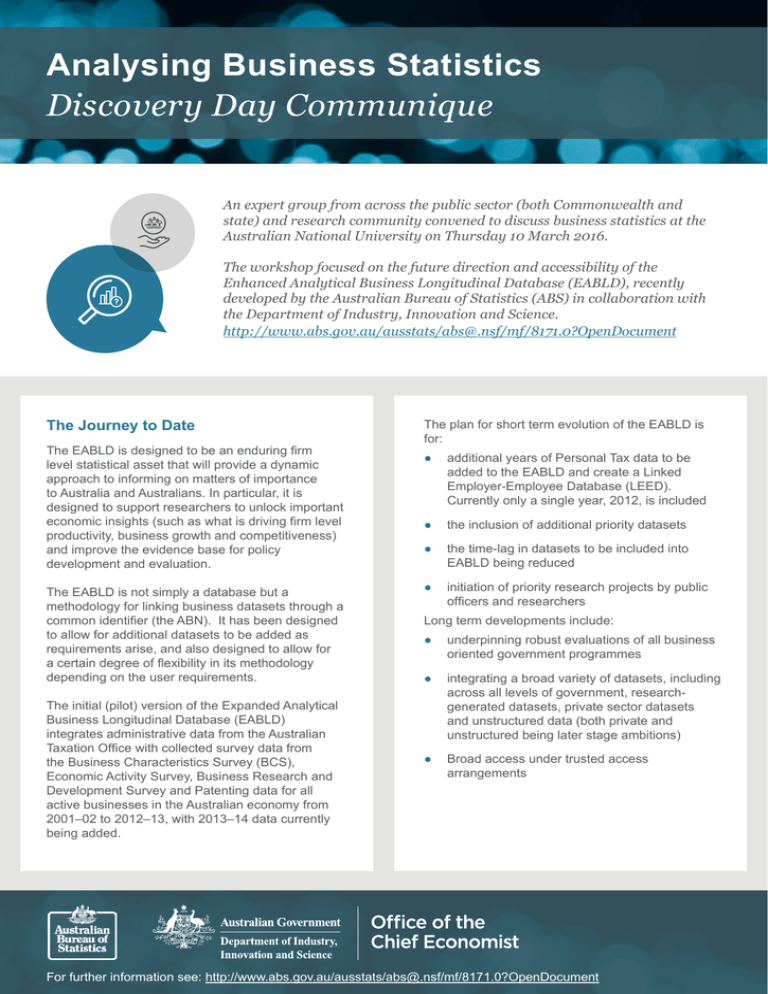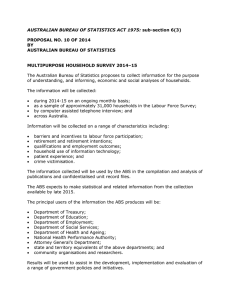Analysing Business Statistics Discovery Day Communique
advertisement

Analysing Business Statistics Discovery Day Communique An expert group from across the public sector (both Commonwealth and state) and research community convened to discuss business statistics at the Australian National University on Thursday 10 March 2016. The workshop focused on the future direction and accessibility of the Enhanced Analytical Business Longitudinal Database (EABLD), recently developed by the Australian Bureau of Statistics (ABS) in collaboration with the Department of Industry, Innovation and Science. http://www.abs.gov.au/ausstats/abs@.nsf/mf/8171.0?OpenDocument The Journey to Date The EABLD is designed to be an enduring firm level statistical asset that will provide a dynamic approach to informing on matters of importance to Australia and Australians. In particular, it is designed to support researchers to unlock important economic insights (such as what is driving firm level productivity, business growth and competitiveness) and improve the evidence base for policy development and evaluation. The EABLD is not simply a database but a methodology for linking business datasets through a common identifier (the ABN). It has been designed to allow for additional datasets to be added as requirements arise, and also designed to allow for a certain degree of flexibility in its methodology depending on the user requirements. The initial (pilot) version of the Expanded Analytical Business Longitudinal Database (EABLD) integrates administrative data from the Australian Taxation Office with collected survey data from the Business Characteristics Survey (BCS), Economic Activity Survey, Business Research and Development Survey and Patenting data for all active businesses in the Australian economy from 2001–02 to 2012–13, with 2013–14 data currently being added. The plan for short term evolution of the EABLD is for: ●● additional years of Personal Tax data to be added to the EABLD and create a Linked Employer-Employee Database (LEED). Currently only a single year, 2012, is included ●● the inclusion of additional priority datasets ●● the time-lag in datasets to be included into EABLD being reduced ●● initiation of priority research projects by public officers and researchers Long term developments include: ●● underpinning robust evaluations of all business oriented government programmes ●● integrating a broad variety of datasets, including across all levels of government, researchgenerated datasets, private sector datasets and unstructured data (both private and unstructured being later stage ambitions) ●● Broad access under trusted access arrangements For further information see: http://www.abs.gov.au/ausstats/abs@.nsf/mf/8171.0?OpenDocument The EABLD ▼ Improves evidence base Enduring for policy development and evaluation firm level statistical asset A statistical asset of national importance Unlocks insights into firm productivity, business growth and competitiveness Initial investigations Data Access: Policy and Practice Three pilot projects which have used the EABLD presented their experiences in accessing and using the EABLD. ●● Impacts of VICStart and TRIP-ICT program The ABS is currently transforming its’ approach to microdata access, informed by the EABLD trials. The transformation is looking to place greater emphasis on the users of the microdata rather than relying solely on the environment in which the data is used. ●● The employment dynamics of Australian Entrepreneurship Access to the EABLD will be based on the five safes framework: Lessons learnt from the pilot projects were: ●● Safe People ●● The challenges associated with remote access to the EABLD ●● Safe Projects ●● R&D Tax Measures and their effectiveness ●● The need to understand and adopt ABS protocols. The ABS have introduced a training program for first-time EABLD researchers ●● The need to be clear on project aims and scope ●● Test confidentiality limits early ●● As the EABLD is data-rich resource, it is sufficiently large to derive statistically significant results and can produce greatly nuanced results Future research directions Participants engaged in an open and robust discussion about future research directions. Suggestions ranged from those currently possible, to those that would become possible in the future with the inclusion of additional datasets. ●● Safe Settings ●● Safe Data ●● Safe Output By moving from a dominant focus on Safe Data to a stronger focus on Safe People creates opportunities to retain the quality of fine level data. There was clear recognition of the improvement of this approach over previous access models. Summation The EABLD is a statistical asset of national importance that will continue to be enhanced. The ABS will continue to improve access arrangements to researchers and government agencies. Options for high priority projects have been identified and selected projects will proceed in the short term.


